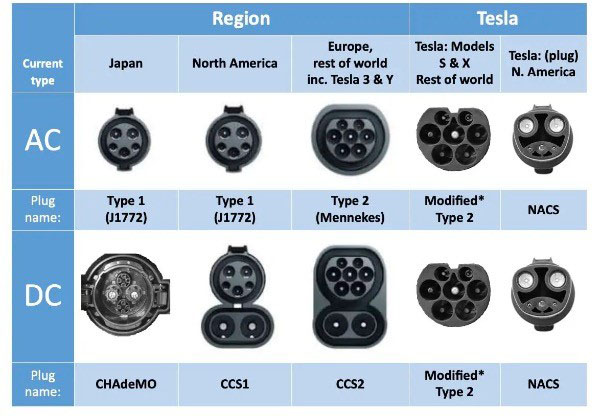The newest status analysis of 5 EV charging interface standards
At present, there are mainly five charging interface standards in the world. North America adopts the CCS1 standard, Europe adopts the CCS2 standard, and China adopts its own GB/T standard. Japan has always been a maverick and has its own CHAdeMO standard. However, Tesla developed electric vehicles earlier and had a large number of them. It designed a dedicated NACS standard charging interface from the very beginning.
The CCS1 charging standard in North America is mainly used in the United States and Canada, with a maximum AC voltage of 240V AC and a maximum current of 80A AC; a maximum DC voltage of 1000V DC and a maximum current of 400A DC.
However, although most car companies in North America are forced to adopt the CCS1 standard, in terms of the number of fast charging superchargers and the charging experience, CCS1 is seriously behind Tesla NACS, which accounts for 60% of the fast charging in the United States. market share. It was followed by Electrify America, a subsidiary of Volkswagen, with 12.7%, and EVgo, with 8.4%.
According to data released by the U.S. Department of Energy, on June 21, 2023, there will be 5,240 CCS1 charging stations and 1,803 Tesla super charging stations in the United States. However, Tesla has as many as 19,463 charging piles, surpassing the U.S. The sum of CHAdeMO (6993 roots) and CCS1 (10471 roots). At present, Tesla has 5,000 super charging stations and more than 45,000 charging piles worldwide, and there are more than 10,000 charging piles in the Chinese market.
As charging piles and charging service companies join forces to support the Tesla NACS standard, the number of charging piles covered is becoming more and more. ChargePoint and Blink in the United States, Wallbox NV in Spain, and Tritium, a manufacturer of electric vehicle charging equipment in Australia, have announced support for the NACS charging standard. Electrify America, which ranks second in the United States, has also agreed to join the NACS program. It has more than 850 charging stations and about 4,000 fast charging chargers in the United States and Canada.
In addition to the superiority in quantity, car companies “rely on” Tesla’s NACS standard, often because of a better experience than CCS1.
The charging plug of Tesla NACS is smaller in size, lighter in weight, and more friendly to the disabled and women. More importantly, the charging speed of NACS is twice that of CCS1, and the energy replenishment efficiency is higher. This is the most concentrated issue among European and American electric vehicle users.
Compared with the North American market, the European CCS2 standard belongs to the same line as the American standard CCS1. It is a standard jointly launched by the Society of Automotive Engineers (SAE), the European Automobile Manufacturers Association (ACEA) and the eight major automakers in Germany and the United States. As mainstream European car companies such as Volkswagen, Volvo, and Stellantis tend to use the NACS charging standard, the European standard CCS2 is having a hard time.
This means that the combined charging system (CCS) standard prevailing in the European and American markets may be quickly marginalized, and Tesla NACS is expected to replace it and become the de facto industry standard.
Although major car companies claim to continue to support the CCS charging standard, it is only to obtain government subsidies for the construction of electric vehicles and charging piles. For example, the U.S. federal government stipulates that only electric vehicles and charging piles that support the CCS1 standard can get a share of the $7.5 billion government subsidy, even Tesla is no exception.
Although Toyota sells more than 10 million vehicles annually, the status of the CHAdeMO charging standard dominated by Japan is quite embarrassing.
Japan is keen to establish standards globally, so it established the CHAdeMO interface standard for electric vehicle charging very early. It was jointly launched by five Japanese automakers and began to be promoted globally in 2010. However, Japan’s Toyota, Honda and other car companies have huge power in fuel vehicles and hybrid vehicles, and they have always moved slowly in the electric vehicle market and lack the right to speak. As a result, this standard has not been widely adopted, and it is only used in a small range in Japan, Northern Europe, and the United States. , South Korea, will gradually decline in the future.
China’s electric vehicles are huge, with annual sales accounting for more than 60% of the world’s share. Even without considering the scale of overseas exports, the large market for internal circulation is enough to support a unified charging standard. However, China’s electric vehicles are going global, and the export volume is expected to exceed one million in 2023. It is impossible to live behind closed doors.
